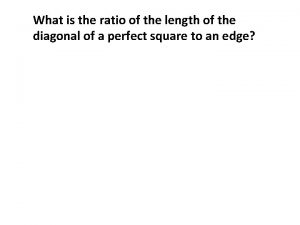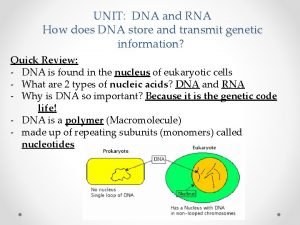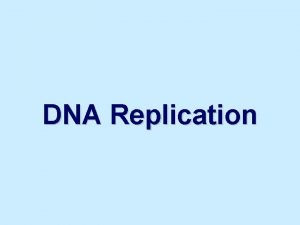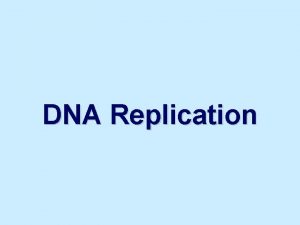DNA Replication DNA Length DNA molecules are surprisingly









- Slides: 9

DNA Replication

DNA Length • DNA molecules are surprisingly long. • The nucleus of a human cell contains more than 1 meter of DNA. • DNA must be folded and coiled in order to fit in such a small space.

Structure of Chromosomes • Chromosomes are made up of chromatin. – Chromatin is DNA tightly coiled around proteins called histones. – DNA and histone molecules form packets called nucleosomes, which fold enormous lengths of DNA into tiny spaces.

DNA Replication • DNA is a double helix (two strands wound around each other). • Each strand has ALL the info needed to reconstruct the other half by the mechanism of base pairing.

Base Pairing • If you separate the two strands, the rules of base pairing allow you to reconstruct the sequence of the other strand. • A=T • G=C • Before mitosis (cell division), the cell duplicates its DNA in a process called replication.

DNA Replication • During DNA replication: – The DNA molecule separates into 2 strands. – 2 new complementary strands are produced following the rules of base pairing. • Each strand of the double helix of DNA serves as a template for the new strand.

How DNA Is Replicated • DNA replication is carried out by a series of enzymes. • The enzymes “unzip” (separate the strands) of a molecule of DNA. • The unzipping occurs when the hydrogen bonds between the base pairs are broken.

How DNA Is Replicated • Each strand serves as a template for the attachment of complimentary bases. – Example: TACGTT produces ATGCAA (complimentary) • Each DNA molecule resulting from replication has one original strand one new strand.

Enzymes in DNA Replication • The principle enzyme involved in DNA replication is called DNA polymerase. • It attaches (or polymerizes) individual nucleotides to produce DNA. • DNA polymerase also “proof-reads” each new DNA strand, helping to maximize the odds that each molecule is a perfect copy of the original DNA.
 Bioflix activity dna replication dna replication diagram
Bioflix activity dna replication dna replication diagram Insidan region jh
Insidan region jh Dna polymerase function in dna replication
Dna polymerase function in dna replication Chapter 11 dna and genes
Chapter 11 dna and genes Organic molecules vs inorganic molecules
Organic molecules vs inorganic molecules What is the ratio of the length of to the length of ?
What is the ratio of the length of to the length of ? Dna replication steps
Dna replication steps Orc dna replication
Orc dna replication Dna replication phschool
Dna replication phschool Dna replication in bacteria occurs
Dna replication in bacteria occurs

















